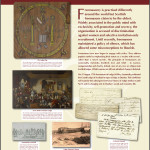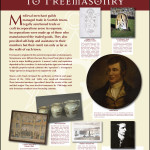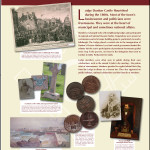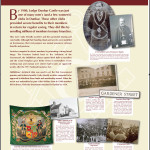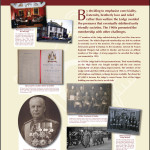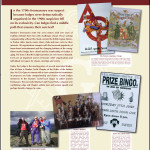THE LODGE
It may appear surprising that the Freemasons lodge named The Lodge of Dunbar Castle has regularly been holding meetings in the town for almost 300 years.
But since 1758 the lodge has established a place in Dunbar’s history with its membership ranging across many walks of life from within this ancient royal burgh. This burgh that was in 1838 the birthplace of the pioneering conservationist John Muir. In 1849 the 11 year old John immigrated with his family to the Americas were they settled in Wisconsin. He founded the Sierra Club in 1892.
Town life in Dunbar at the beginning of the story of the Masonic Lodge of Dunbar Castle, is a much stranger world to us than that of say one hundred and fifty years ago, and the following notes may serve to give a clearer picture.
The Jacobites
The Jacobite’s had made their last open attempt to recover the throne in 1745 and political unrest continued for some time in differing degrees. There were stables of dragoons in the town, intermittently occupied, and even up to 1758, when our story begins. The Councillors were required not only to subscribe to the “oath of allegiance” to His Majesty King George the Second but also to take the “oath of abjuration” of the Stewart dynasty, represented in the person of the Young Pretender, Bonnie Prince Charlie, who died in France in 1788. It is clear, however, from their Address presented to the Hanoverian King George after the defeat of the clans at Cullodon that the Magistrates and Councillors of the Royal Burgh of Dunbar had no sympathy for the “rebells” or the Stewart cause.
Houses
The Burgh of Dunbar consisted in those days of the High Street and the old Harbour, here activity was concentrated, and the closes in between where mosyt of the people lived. Towards the middle of the century houses in Scottish towns improved generally, with slates replacing turf and thatch on roofs and stone the wooden frames for walls. The description of Dunbar given in the First Statistical Account of Scotland of 1793 states “the houses are much improved of late and make a very genteel appearance”.
The High Street
The High Street was first causewayed in 1737, before which it must have been a very rough and, in wet weather, muddy thoroughfare. Even after that, there seems to have been a stream running through it, for there is a record of 1759 of ‘the water that runs from the High Street to sea’ being taken ‘by a Cannall’ through the garden of a maltster for his business. Water would be obtained mostly from wells, but an improvement was made in 1766 when leaden pipes were laid to bring water from wells near Spott. Lamp lighting in the streets came in 1785, so that the torches in processions mentioned later may have been in the first instance necessary for lighting the way.
Occupations
The years 1760-1780 in Britain saw the installation of the first major mechanical inventions for harnessing power to manufacturing and for multiplying production. The spread of the Industrial Revolution in Scotland produced a complexity of change. New kinds of employment began to appear, a number of occupations slowly or quickly vanished, while there was a tendency for many types of business to become localised, the country ones moving to the towns, the town ones shifting to the cities. For example, shopkeepers superseded the travelling packman, whose wares ranged from thread to the latest popular pamphlet. The spinning of wool (a task for womenfolk in some local farms up to 1815), the weaving of homespun (carried out in the village wabster’s shop), and the making of broadcloth garments (by the travelling tailor), all customary and accepted when the story starts, have mostly disappeared before it is half told. Application had to be made to the Council to become a “Stallinger” with permission to erect a stall in the street on Market and Fair Days. The town was growing.
Dress
In 1800, dress was mostly quite changed from that of 1750, when men wore knee-breeches, long stockings, a full jacket or coat, with the distinctive Scots bonnet on the heed. Wool was partly replaced by linen made locally, and then cotton, and bleaching became a common task. In172 wooden pipes were laid to the Bleach Field ( on the site of the new Bleachingfield Centre), and were replaced in 1777 by leaden ones.
Food
There was also a change in diet. Peasmeal, oatmeal and barley bannocks gave place to wheaten bread and baxter’s shops were opened. Sowens, an oatmeal dish, were supplemented by potatoes, which began to be extensively cultivated only in1750. With the imposing of a malt tax, home brewed and other ale was largely superseded by spirits, much of it smuggled from the Continent. Tea was just becoming widespread as a beverage. The improvement and increase in the growing of turnips meant that cattle could be wintered and the slaughterings of the “Martinmas Mart” in November to give meat for salting during the cold months decreased. Previously, fresh meat in winter had been extremely scarce. In Glasgow, ‘on the rare arrival of fresh meat in winter, the bellman went along the streets announcing the exciting fact’. Afterwards, beef became a popular food, and immense quantities were consumed, as is evidenced by entries in the Lodges Stewards’ Book. For example, for the supper following a St. John the Baptist Day Festival in the Masonic Lodge in 1811, when 45-50 persons can be surmised as present, 44lbs, of Beef and 54 Pyes were bought.
Habits
The habits of the people were vastly different from those of today, and might on the whole be shortly described as a pattern of ‘early to bed and early to rise’. Much of the rhythm of town life was regulated by the burgh officials, the Town Drummer and Town officer keeping the citizens acquainted with the passing of time and the march of events. In 1760 the retired Town Officer who had held the position for 30 years and was ‘old and upon decline of life’ petitioned the Council to grant him the ‘Benefit of the Town’s Drum as there was no Established Drummer at present’. Daily in the morning and evening, the Town’s cattle would be seen being driven to and from the Inner Common by the Town’s Herd. In 1803, when Mrs Hay, Dowager of Spott, came to live within the Burgh, she was granted “the liberty of pasturing her cow upon the Common of Dunbar”.
Roads
Perhaps no single source of change had a greater power of transformation than the improvement of the roads. Not only did greater ease of travel quicken the speed of commerce, but better facilities for communication promoted the interchange of ideas and the dispersal of information. The appalling state of the roads in the early part of the century can be guessed from the fact that up to about 1750 a stage coach went only once a month from Edinburgh to London, taking twelve to sixteen days. In the same year, a whole winter’s day was spent by a coach with four horses in travelling the sixteen miles from Edinburgh to Haddington. In 1770 a carrier from Selkirk to Edinburgh found it easier to travel up the channel of Gala Water than use the road, and took two weeks for the double journey or 76 miles. On side roads, horse and cart would almost completely disappear in mud holes.
Local tolls had been imposed since 1714, but the great improvements came in 1750-1760 largely by reason of the Turnpike Road Act of 1751, which empowered Road Commissioners to levy a more adequate assessment. The Commissioners for East Lothian were the first north of the Tweed to take advantage of the Act and in 1755 Dunbar Town Council sent representatives to a meeting in Haddington for establishing a Turnpike Road at Beltonford. Some ten years later, the Great Post Road ran through Dunbar, milestones marked the distance along it and the Union and Mail Coaches changed horses daily at the George Hotel. “Nothing wrought so remarkable a change in civilising the country, in developing its trade, and improving the social and industrial condition of the people, as the Turnpike Road Act of 1751” (Graham).
Farming
In the countryside round about changes were also taking place which were reflected in the Burgh. Rather quickly, farming began to improve and this period records one of the early far-reaching developments in farm machinery, when a thrashing mill, driven by water, horse or man power, was perfected at Phantassie by Andrew Meikle of East Linton (of whom more later) in 1784. Prior to this, thrashing was done by hand-flails (though some mechanical ones had begun to appear), and the importance of the invention can be judged from the fact that about twenty years after, 350 thrashing mills had been built in East Lothian alone. A poem, a dialogue between the thrashing machine and the flail, appeared in The Farmers’ Magazine in 1810 of which the following is a verse, (‘Nout’ is ‘Neat’ or ‘Cattle’)
“When round my axletree I reel,
Wi’ men, wind, nout, or water-wheel,
In twenty minutes, or I’m a de’il
I’ll clean mair strae,
Than you, if ye will thrash it well,
In a hail day.”
Linen was all the rage, and was considered at one time to be a great advantage for Scottish economy. The British Linen Company Bank was chartered in 1747 to finance projects and a branch opened in Dunbar in 1788. Flax was grown widely and small lint mills were erected in the lower valleys where water for machinery and processing was available, but though the industry had a spectacular rise it had a no less spectacular decline in all but a few counties after 1785-1800, when the cotton mills became established. Ruins of these lint mills may still be seen by burn-sides in the County. In 1792 a flax and cotton mill was erected at West Barns, but it did not long survive.
The Weather
And the weather – what of it? Has it been better, the same or worse over two centuries? Only statistics could show. Yet this can be stated. A prolonged spell of bad weather was much more calamitous then than today. However, there is one common feature over years of our story, namely, that people often thought the weather should be bettet than it was and, in fact was getting worse- a sentiment not unknown today !
Here is a verse written of the year 1879 by Samuel Mucklebackit of East Linton:-
“Sin’ ere the Seeventy-an’-Yin,
The seasons hae been vexin’
Till, waur an’ waur, this Seeventy-Nine
Has grown past a’ perplexin’
What’s to be dune? This noddle mine,
Baith late an’ ear’ I’m axin,
But less the answer I divine
The mair my wuts I’m taxin’.”
Extract from The History of Dunbar Castle Lodge 1758 ~ 1958 Bicentenary Year by J.S McMartin M.C., M.A.
250 YEAR ANNIVERSARY 1758 – 2008.
During the year of 2008 The Lodge of Dunbar Castle celebrated its 250th anniversary.The opening of the Dunbar lodge of Freemason in 1758 had been encouraged by members of similar lodges in Eyemouth and Haddington. The members from these local lodges petitioned the recently formed Grand Lodge of Scotland, head-quartered in Edinburgh, to establish a meeting place in Dunbar.To celebrate and mark this occasion East Lothian Council Library, now The John Gray Centre, and Dunbar History Society held an exhibition in Dunbar Town House Museum.
The following canvases are those used by ELCL to depict the 250 years history. They show how times for the lodge have changed since its opening in 1758 and how life in the community has developed over the centuries.

